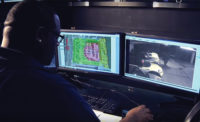The wholesale central station business is a multi-faceted one, and companies in this business are keen on innovation, adding new capabilities every year. A few commonalities emerged as we spoke with central stations for this year’s annual roundup of wholesale monitoring. Video verification is hot, and so are new methods of communicating with customers about their systems and alarms, including text messaging and apps. We’re also beginning to see ASAP-to-PSAP becoming a reality in some areas, with the expectation being that next year could be a watershed one for the technology.
Read about these developments and more, below.
American Digital Monitoring (Seattle)
American Digital Monitoring has been having success with VirtuAlarm, an IP transmitter developed by its sister company Cencom.com Inc., notes CEO Ron Cats.
As Cats explains, it can be difficult or impossible for a dealer to change which central station alarm signals from other IP systems go, but VirtuAlarm is designed to enable dealers to change central stations in real time via an online dashboard. Dealers pay a $2 monthly fee for the routing service and an additional $2 a month if they want American Digital to monitor the system. VirtuAlarm can be used with previously installed or newly installed alarm systems.
American Digital also offers an option for what are sometimes called do-it-yourself, or DIY, systems designed for end users to install. With this option, American Digital bills the end customer directly for a $2 monthly charge. When an alarm occurs, the information is sent to the end customer’s smartphone, and via an app the customer can push a button to call the police or to cancel the alarm if the alarm was accidental.
If the customer chooses to contact the police, the appropriate authority is called, even if the customer is not in the area at the time, Cats explains. He adds that end user customers have the option of turning on this capability as needed — for example, only when they are out of town.
Criticom (Longwood, Fla.)
Criticom continues to enhance the company’s dealer portal, which was developed by an outside software company. A recent enhancement was to interface that portal and the company’s Mastermind central station automation system with the company’s answering service platform.
“If you’re logging in as a technician or office staff of an alarm company, you can see within an account if the account called in for emergency service within the event history,” explains Criticom President Tony Wilson. “Now everything is in one place.”
Another new capability that is now available to Criticom dealers for a fee is a service that matches properties for sale on multiple listing services with dealer accounts. Armed with that information, the dealer can offer a free system inspection and leave behind a brochure they can give a buyer or offer an incentive to homeowners that helps persuade the buyer to continue having the system monitored.
Criticom also has made advances in using text messaging to communicate with accounts. A key challenge is that telecom providers may view texting to a large number of accounts as spam and block it, Wilson explains; but Criticom avoids this because it obtained a five-digit short code from its provider.
COPS Monitoring (Williamstown, N.J.)
COPS Monitoring has gone “all-in” on mobile PERS (mPERS), observes COPS President Jim McMullen. Internal programmers integrated GPS monitoring and mapping software into COPS’ proprietary API and monitoring platform to facilitate mobile device monitoring and to dynamically identify the correct authorities. The company also built a dedicated mPERS dispatch center inside its headquarters and one other site for redundancy. Dispatchers have received training such as CPR and HIPAA compliance and the company has a certified EMT on staff.
According to McMullen, COPS is the only monitoring provider with a proprietary UL-listed monitoring platform, which it has now migrated to a jBASE platform from ZumaSys. In just a short time, the company has seen reporting speeds that are dramatically faster than with the previous platform.
COPS also
created MY--
ALARM.CHAT, an application that uses text messaging to notify customers of alarms and enables them to communicate with other authorized users in a secure chat room. It also gives customers the ability to cancel or escalate alarm signals.
Dynamark Marketing (Hagerstown, Md.)
Dynamark Marketing added a panic capability to its smartphone app this year and has been delighted with the results.
“Even though the alarm isn’t set, you can . . . hit the panic button and we can GPS you and dispatch police to where you are,” explains Keith Godsey, Dynamark senior vice president.
Dynamark doesn’t charge extra for this service, which is popular even among those who don’t arm their system regularly, Godsey observes.
The capability is also popular with realtors who keep the app open while hosting an open house.
The Dynamark app also gives end users the ability to cancel an alarm even before it reaches the central station when the system is tripped by accident. The capability has made customers a lot stickier by enabling them to avoid false alarm fines that run as high as $250, he says.
Video verification is also hot, Godsey notes. “Five years ago, we might [add] one or two video monitored accounts per month, now it’s 50 to 100 a month.”
The central station has helped with as many as four apprehensions per month.
Dynamark also expects to save 20 to 30 seconds per dispatch by using ASAP-to-PSAP. At press time in early November, the company was about to turn up connectivity to one PSAP, to be followed by six more.
Emergency24 Inc. (Des Plaines, Ill.)
Emergency 24 continues to develop services, as well as applications, that help dealers be more efficient and get more recurring monthly revenue, comments Kevin Lehan, national sales and marketing manager for Emergency24.
He notes, for example, that Emergency24 now offers video verification from Chekt, which he says is a great solution for retrofits that have an unmonitored camera. The Chekt offering easily integrates with a wide range of cameras, enhancing the power of existing customers’ systems and enabling dealers to get more RMR from existing accounts, according to Lehan.
Emergency24 also has rolled out two-way texting capability between customers and operators. The company uses this capability to, for example, alert customers to a low battery.
“They can respond to it and it records into their history,” Lehan notes.
Texting offers a more immediate alternative to a smartphone app for communication with the central station, notes Steve Mayer, vice president of operations and administration for Emergency24. “Some phones are cluttered and you have to find [the app],” he explains. “With texting, there’s a lot faster transaction and response.”
Mayer also notes that Emergency24 continues to enhance its dealer portal by adding new training options, for example. The portal also has been enhanced to better serve customers that have multiple locations by offering a wide range of access levels.
Mayer also offers brief details about upcoming news, including strategic partnerships to enhance value and RMR. In addition, the company plans to incentivize dealers to convert accounts to IP monitoring.
Metrodial Central Station (Hicksville, N.Y.)
Metrodial has been migrating central station functionality into the cloud — a move that will provide a range of benefits, explains Andy Lowitt, vice president for Metrodial.
“You don’t have to buy new equipment every few years for your central station,” he observes. Another advantage is that software updates are handled in the cloud, eliminating the need for Metrodial to manage them and enabling them to occur more promptly. Using the cloud also provides redundancy, he adds.
Another key initiative for Metrodial is to expand the wireless coverage that the company offers its dealers by installing AES-IntelliNet radios in metro New York City, where Metrodial is headquartered and has many accounts. Because AES uses a mesh approach, the offering becomes stronger the more radios that are installed. Dealers view the AES approach as more future-proof in comparison with cellular technology, which becomes obsolete after several years and must be replaced, Lowitt says.
Metrodial hopes to roll out ASAP-to-PSAP capability in 2020, Lowitt notes.
National Monitoring Center (Lake Forest, Calif.)
National Monitoring Center (NMC) now offers a service that combines video analytics with operator support and two-way communications capability. Operators can investigate movement on a protected property and push away intruders before they can do damage.
“What is new is leveraging analytics to reduce false triggers and only trigger what we want to see,” explains Graham Grant, NMC vice president of proactive video monitoring.
Another recent NMC innovation was to integrate a PSAP database called West with the company’s Mastermind central station automation system to enhance the NMC mobile PERS offering. When the central station receives an alarm from an mPERS user, the system automatically taps into the database to retrieve the appropriate dispatch center.
NMC is one of several central stations SDM spoke with that is monitoring Chekt video verification technology that integrates with a wide range of cameras. And like some other central stations, NMC is making heavier use of text communications with accounts. To maximize its ability to reach customers via texting, NMC enlisted a service that will confirm if a phone number is a cellphone to which NMC can text.
NMC also has found opportunity in new laws that require some central stations to add locations. The company is entering agreements with some of these companies to act as an additional location. This, in turn, has opened up opportunities for what Grant calls a “hybrid model,” in which another company operates its own central station during certain hours but uses NMC during other hours.
Rapid Response Monitoring Services Inc. (Syracuse, N.Y.)
Reducing false alarms has been a key focus for Rapid Response Monitoring. Rapid Response currently clears 85 percent of alarms before police are dispatched, notes Morgan Hertel, Rapid Response vice president of technology and innovation. “Ten years ago, we were lucky if we cleared 20 percent,” he comments.
Today, he notes, “we’re really looking at how to make a difference for the 15 percent that do get dispatched.”
One aspect of that is to connect to public safety answering points (PSAPs) using ASAP-to-PSAP technology. Rapid Response works closely with The Monitoring Association and has active connects with all PSAPs integrated with ASAP-to-PSAP.
A key capability that enables is to cancel alarms while an operator is waiting to speak with the PSAP.
“We can cancel calls from the service,” Hertel explains.
Another benefit of ASAP-to-PSAP is that police will never be sent to the wrong place because addresses in the central station’s database are verified against the PSAP’s database and exact matches are made before a central station can begin sending alarms using the new technology; and when police are dispatched, the system automatically uses the matched address.
Rapid Response also developed a method of notifying customers of alarm signals via text messages that are keyed to a web-based app that lets customers cancel the alarm. When homeowners or people on their call list prefer to be reached by phone, Rapid Response’s interactive voice response system leaves a message, thereby shortening the notification process.
Security Central (Statesville, N.C.)
Security Central will be opening its third central station in Knoxville, Tenn., in spring 2020, notes Security Central President Caroline Brown. The company also has enhanced cyber security, including for cloud services.
In addition, “we’re overhauling how operators function,” she explains. The company introduced an app for operator scheduling that enables operators to swap shifts with one another, for example.
The company has expanded its video verification options to include an offering from Chekt that conforms to the ONVIF standard, enabling it to work with a wide range of video cameras, notes Jamie Byrd, director of research, development and tech support for Security Central. In addition, the platform lets operators see an overlay of the property and placement of cameras.
Other new Security Central offerings include a personal emergency response system (PERS) from Essence that the company sells to its dealers and the Solo Protect ID offering designed specifically for lone workers. Solo Protect ID is a discreet badge-style device that can send a silent alarm to the central station.
“There is no audible sound to intensify the situation,” Byrd explains.
SentryNet, a division of Stanley Security (Memphis, Tenn.)
SentryNet is one of several central station monitoring companies that Stanley Security has acquired worldwide and a key focus has been to get all of the properties onto common systems, explains Mike Wardlow, dealer sales manager for SentryNet.
“We’re going through a transition and moving to one global platform,” Wardlow observes. Benefits will include faster response, increased automation and greater efficiencies, he says.
The company also is enhancing and expanding tools for dealers and end users. He notes, for example, that customers can request service using an app or secured browser. The app can be labeled with the dealer’s branding.
SentryNet is also expanding the security equipment it can support. Wardlow says, for example, that the company is looking to offer monitoring for 3XLogic video surveillance equipment on a wholesale basis.
Another SentryNet initiative is operator training, Wardlow notes. “We don’t want anyone to fail,” he says. “We put a lot of focus on training.”
Stealth Monitoring (Addison, Texas)
Stealth Monitoring focuses primarily on video verification and has the distinction of being one of the first, if not the first, central station to receive UL certification for managed video services — a new category of monitoring created by UL.
“People have been asking for it,” says Colin Bodbyl, chief technology officer for Stealth Monitoring.
Moving forward, Stealth Monitoring will be monitoring more complex situations, Bodbyl explains.
The company already does complex monitoring using highly trained operators to monitor shopping plazas, he notes, but adds that the company plans to augment this by using artificial intelligence to, for example, determine if homeless people are sleeping in a parking garage. Other aspects of shopping plaza monitoring include looking for people breaking into cars in a parking lot and ensuring that signage is working properly or that gates are closed for the night.
Stealth Monitoring also has a concierge service to replace front desk personnel in residential markets by opening doors remotely and monitoring cameras. The company offers a similar service for guard houses in gated communities that can validate people via a call list, check license plates and call residents. The company is piloting an offering that would provide business intelligence by counting people and vehicles or monitoring noise levels.



